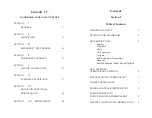
D.C. GENERATION (cont.)
(3) Alternator Nomenclature
(a) Bearings: These units have a sealed ball bearing at the drive end and a two-piece roller bearing
at the slip ring end. The inner race is pressed onto the rotor shaft and the rest of the bearing is
in the slip ring end head. When the unit is assembled, the inner race aligns with the bearing.
When the bearing is replaced, the new inner race must be installed on the rotor shaft.
(b) Lubrication: The slip ring end bearing should be lubricated whenever the alternator is
disassembled. The bearing should be thoroughly cleaned and repacked with Shell Alvania
No. 2 or an equivalent bearing lubricant. The cavity behind the bearing should be packed
one-third to one-half full with the same lubricant.
(c) Brushes: These units have a separate brush holder assembly that is installed after the alternator
has been assembled. The brush holder has a small hole that intersects the brush cavities. Use
a pin or a piece of wire, as shown in Figure 2 to hold the brushes in the holder during assembly.
Remove the pin after the brush holder retaining screws have been tightened. Make a continuity
check to be sure the brushes are seated against the slip rings.
(d) Drive Pulley: Torque the drive pulley retaining nut to 35 foot-pounds.
(4) Checking Alternator System
With all electrical equipment off (except master switch) the ammeter will indicate the amount of
charging current demanded by the battery. This amount will vary, depending on the percentage of
charge in the battery at the time. As the battery becomes charged, the amount of current displayed
on the ammeter will reduce to approximately two amperes. The amount of current shown on the
ammeter will tell immediately whether or not the alternator system is operating normally, if the
following principles are kept in mind.
— NOTE —
The amount of current shown on ammeter is load in amperes
that is demanded by the electrical system from the alternator.
As a check, for example assume a condition where the battery
is demanding 10 amperes charging current, then switch on the
landing light. Note the value in amperes placarded on the cir-
cuit breaker panel for the landing light circuit breaker (10
amps) and multiply this by 80 percent, you will arrive at a cur-
rent of 8 amperes. This is the approximate current drawn by
the light. Therefore, when the light is switched on, there will be
an increase of current from 10 to 18 amperes displayed on the
ammeter. As each unit of electrical equipment is switched on,
the current will add up and the total, including battery, will
appear on ammeter.
PIPER AIRCRAFT
PA-32R-301/301T
MAINTENANCE MANUAL
24-30-00
Page 24-10
Reissued: July 1, 1993
1K10
Summary of Contents for PA-32R-301T SARATOGA S
Page 26: ...CHAPTER 4 AIRWORTHINESS LIMITATIONS 1C1 ...
Page 29: ...CHAPTER 5 TIME LIMITS MAINTENANCE CHECKS 1C4 ...
Page 53: ...CHAPTER 6 DIMENSIONS AND AREAS 1D6 ...
Page 64: ...CHAPTER 7 LIFTING AND SHORING 1D21 ...
Page 68: ...CHAPTER 8 LEVELING AND WEIGHING 1E1 ...
Page 72: ...CHAPTER 9 TOWING AND TAXIING 1E5 ...
Page 76: ...CHAPTER 10 PARKING AND MOORING 1E9 ...
Page 80: ...CHAPTER 11 REQUIRED PLACARDS 1E13 ...
Page 92: ...CHAPTER 12 SERVICING 1F1 ...
Page 126: ...CHAPTER 20 STANDARD PRACTICES AIRFRAME 1G17 ...
Page 127: ...THIS PAGE INTENTIONALLY LEFT BLANK ...
Page 139: ...CHAPTER 21 ENVIRONMENTAL SYSTEMS 1H5 ...
Page 188: ...CHAPTER 22 AUTOFLIGHT 1J7 ...
Page 193: ...CHAPTER 23 COMMUNICATIONS 1J12 ...
Page 203: ...CHAPTER 24 ELECTRICAL POWER 1J22 ...
Page 263: ...CHAPTER 25 EQUIPMENT FURNISHINGS 2A13 ...
Page 269: ...CHAPTER 27 FLIGHT CONTROLS 2A20 ...
Page 332: ...CHAPTER 28 FUEL 2D11 ...
Page 363: ...CHAPTER 29 HYDRAULIC POWER 2E18 ...
Page 404: ...CHAPTER 30 ICE AND RAIN PROTECTION 2G16 ...
Page 470: ...CHAPTER 32 LANDING GEAR 3A13 ...
Page 550: ...CHAPTER 33 LIGHTS 3D24 ...
Page 562: ...CHAPTER 34 NAVIGATION AND PITOT STATIC 3E12 ...
Page 582: ...CHAPTER 35 OXYGEN 3F8 ...
Page 604: ...CHAPTER 37 VACUUM 3G6 ...
Page 616: ...CHAPTER 39 3G18 ELECTRIC ELECTRONIC PANELS MULTIPURPOSE PARTS ...
Page 620: ...CHAPTER 51 STRUCTURES 3G22 ...
Page 636: ...CHAPTER 52 DOORS 3H14 ...
Page 650: ...CHAPTER 55 STABILIZERS 3I4 ...
Page 662: ...CHAPTER 56 WINDOWS 3I16 ...
Page 670: ...CHAPTER 57 WINGS 3I24 ...
Page 688: ...CHAPTER 61 PROPELLER 3J18 ...
Page 704: ...CHAPTER 70 STANDARD PRACTICES ENGINES 3K10 ...
Page 708: ...CHAPTER 71 POWER PLANT 3K14 ...
Page 737: ...CHAPTER 73 ENGINE FUEL SYSTEM 4A13 ...
Page 749: ...CHAPTER 74 IGNITION 4B1 ...
Page 783: ...CHAPTER 77 ENGINE INDICATING 4C11 ...
Page 793: ...CHAPTER 78 EXHAUST 4C21 ...
Page 801: ...CHAPTER 79 OIL 4D5 ...
Page 805: ...CHAPTER 80 STARTING 4D9 ...
Page 819: ...CHAPTER 81 TURBINES 4D23 ...
Page 833: ...CHAPTER 91 CHARTS WIRING DIAGRAMS 4E13 ...














































